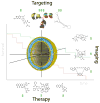Multifunctional nanoparticles: cost versus benefit of adding targeting and imaging capabilities
- PMID: 23161990
- PMCID: PMC3660151
- DOI: 10.1126/science.1226338
Multifunctional nanoparticles: cost versus benefit of adding targeting and imaging capabilities
Abstract
Nanoparticle-based drug delivery systems have been developed to improve the efficacy and reduce the systemic toxicity of a wide range of drugs. Although clinically approved nanoparticles have consistently shown value in reducing drug toxicity, their use has not always translated into improved clinical outcomes. This has led to the development of "multifunctional" nanoparticles, where additional capabilities like targeting and image contrast enhancement are added to the nanoparticles. However, additional functionality means additional synthetic steps and costs, more convoluted behavior and effects in vivo, and also greater regulatory hurdles. The trade-off between additional functionality and complexity is the subject of ongoing debate and the focus of this Review.
Figures


References
-
- Nie SM, Xing Y, Kim GJ, Simons JW. Annual Review of Biomedical Engineering. 2007;9:257–288. - PubMed
-
- O’Brien MER, et al. Ann Oncol. 2004;15:440. - PubMed
-
- Peer D, et al. Nat Nanotechnol. 2007;2:751. - PubMed
-
- Lankveld DPK, et al. Nanomedicine. 2011;6:339. - PubMed
-
- Danhier F, Feron O, Preat V. J Control Release. 2010;148:135. - PubMed
Publication types
MeSH terms
Substances
Grants and funding
LinkOut - more resources
Full Text Sources
Other Literature Sources
Medical

